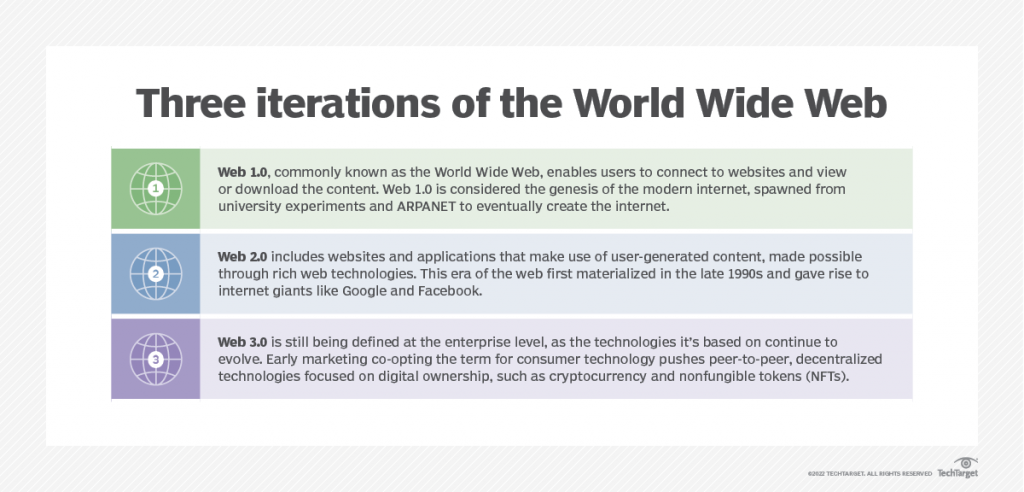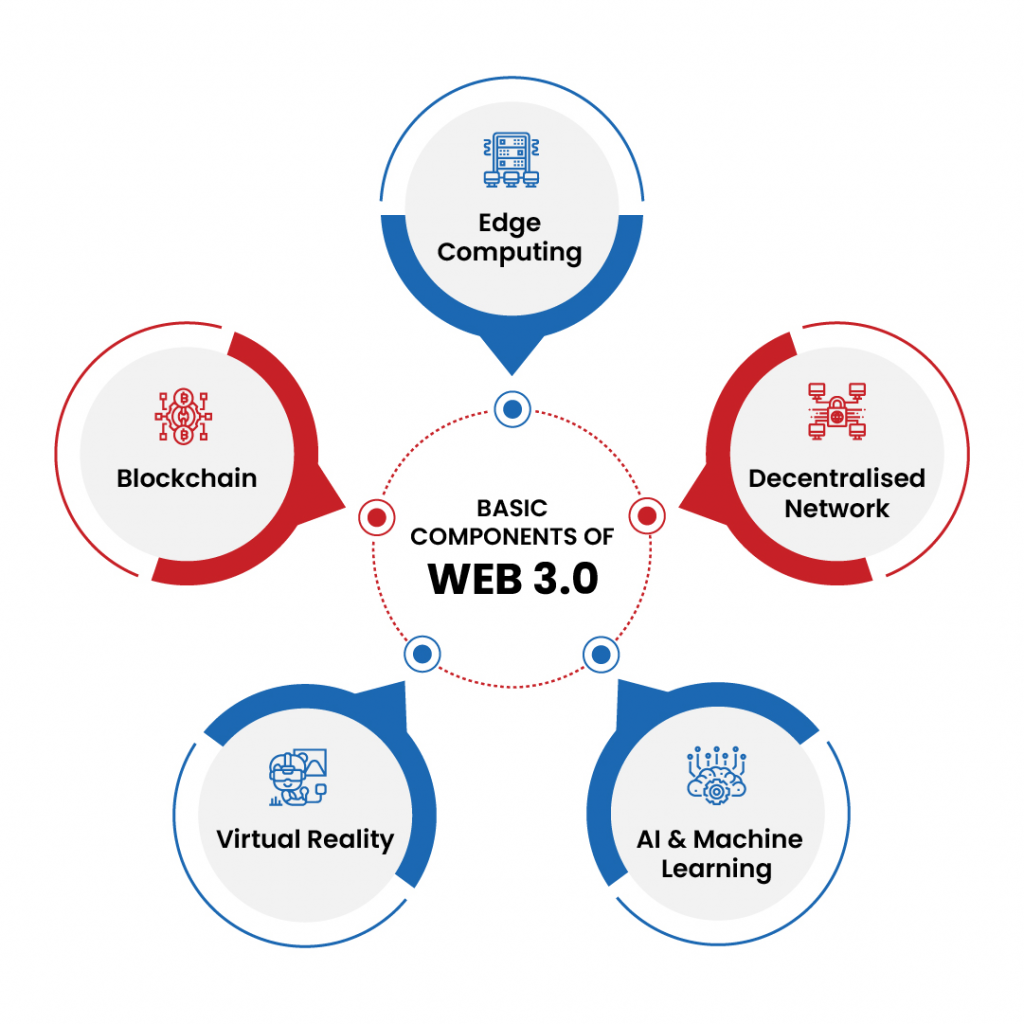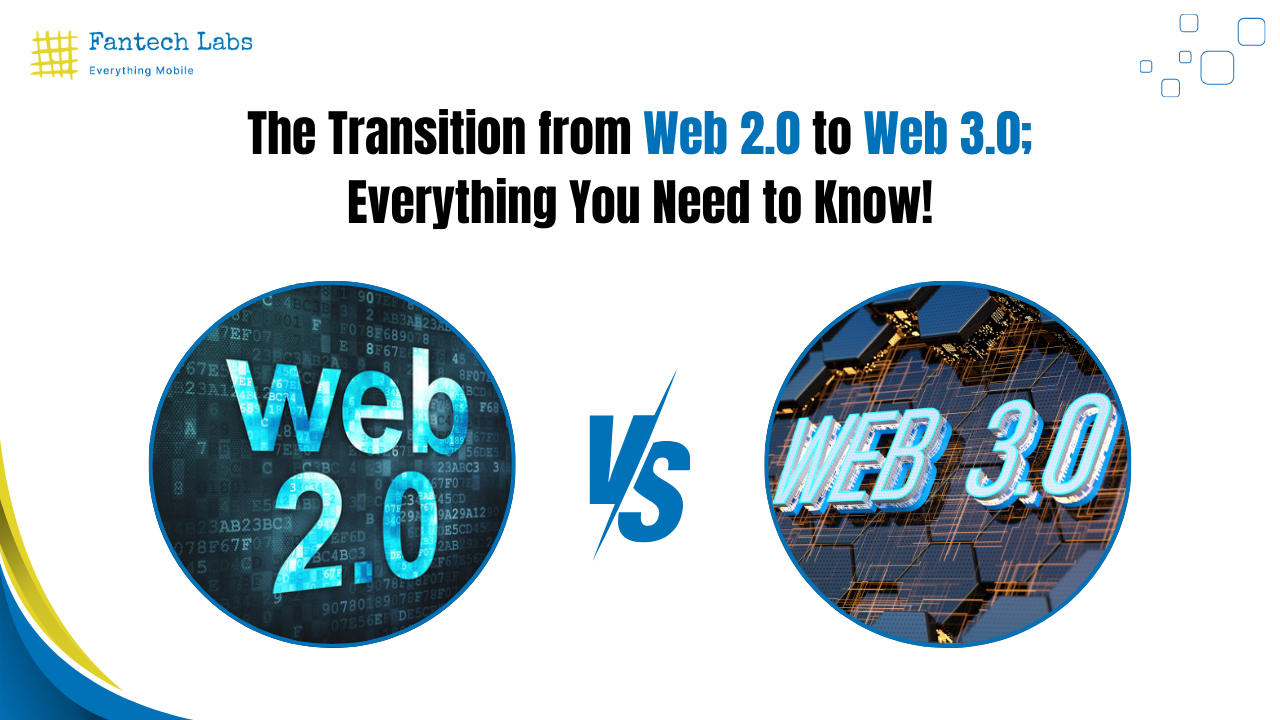The web, short for the World Wide Web, refers to the system of interconnected documents and resources accessed via the internet using web browsers. It’s essentially the network of websites, web pages, and multimedia content that you can browse and interact with.
The Internet has come a long way, starting with Web1 (static words and graphics) and ending with Web2, which is the present version.
The currently approaching Web3 age will allow value and data to flow across decentralized platforms with dispersed ownership and control with ease.
What else, though, is included in Web3? What distinguishes it from Web2? Continue reading to find out more about these two ideas, how they differ, and when they might be used.
From the static Web 1.0 to the dynamic Web 2.0 and the soon-to-be Web 3.0, the internet has evolved significantly.

The Web’s versions
Web 1.0
In 1990, Berners-Lee, a computer scientist at the European Research Centre CERN, led the early development of the Internet.
By October 1990, he had authored the three key technologies that served as the web’s framework. These technologies included the very first webpage editor/browser, WorldWideWeb.app.
- HTML, or HyperText Markup Language, is the markup or formatting language used on the internet.
- Every resource on the internet is identified by a unique address. This unique address is known by a Uniform Resource Identifier (URI) or Uniform Resource Locator (URL).
- HyperText Transfer Protocol is referred to as HTTP. It makes it possible to retrieve pertinent web content.
The Web 1.0 period began with the release of web browsers such as Netscape Navigator by the middle of the 1990s. Static webpages that were downloaded from servers dominated this era. It was a far cry from the glossy material that we now consider standard.
At the time, the majority of Internet users were excited about the new services, such email and real-time news retrieval.
Interactive programs were not widely available to users, and content production was still in its early stages. The popularity of Internet trade and banking increased this engagement.

Web 2.0
“Web 2.0” refers to a paradigm shift in how people use the Internet. Web 2.0, with its social connection, user-generated content, and interactivity, took the place of Web 1.0’s boring web pages in the first two decades of the twenty-first century.
Web 2.0 has made user-generated content accessible to millions of people globally almost instantaneously. This kind of content is growing rapidly due to its unmatched reach.
Thanks to important advancements like social networks and mobile Internet access, Web 2.0 has expanded rapidly. Almost everyone has powerful mobile devices like iPhones and Android smartphones.

Because of these novel notions, apps grew in popularity during the second decade of the millennium.
This greatly increased online activity and ease of use. Examples of these apps are YouTube, Uber, WhatsApp, Facebook, Instagram, TikTok, Twitter (now X), Airbnb, and Facebook.
Numerous businesses, including Apple, Amazon, Google, Meta (formerly Facebook), and Netflix, concentrated on Web 2.0, are now among the biggest companies in the world. This is because of the impressive revenue growth of these leading platforms.

Key Benefits:
1. Dynamic material:
Web 2.0 presents dynamic material that users may edit and engage with, as opposed to Web 1.0’s limited, read-only style.
2. Better social networking:
With Web 2.0, people may stay connected to people worldwide, take part in discussions, and exchange information with friends and family.
3. Usability and information exchange:
Users only need to click to use, update, and share information thanks to Web 2.0. The tracking of any editing done online is also possible.
4. Improved marketability:
By building responsive websites, Web 2.0 enhances user experience for business owners. By using interactive advertising strategies, they can boost their products’ marketability and online advertisement.
5. Higher educational standards:
Web 2.0 makes interactive learning and virtual classrooms possible. e.g, students broaden their study scope by using online calculators for arithmetic problems.
Web 3.0
The next stage of the Internet’s development is called Web 3.0. It could cause as much disruption and represent a significant paradigm shift as Web 2.0. Web 3.0’s core principles include decentralisation, transparency, and increased user utility.
In the 1990s, Berners-Lee developed several of these important ideas, which are as follows:
- Decentralization: The absence of a “kill switch,” a single point of failure, and a central controlling node. Anything put online can be put there without a central authority’s consent. Additionally, freedom from arbitrary censorship and surveillance is implied by this.
- Bottom-up design: More participation and experimentation were encouraged. The code was not produced and managed by a small group of professionals, but rather was built collaboratively.
In 2001, Berners-Lee published a paper that presented the idea of the Semantic Web. The semantics of language, or determining the true context in which a word or phrase is used, was not a dependable task for computers.
The Semantic Web was designed by Berners-Lee as a means of classifying important content on web sites. This would enable users to use software for complex tasks.
The Semantic Web, as first envisioned by Berners-Lee in 2001, has evolved significantly in Web 3.0. This evolution is partly because converting human language into a computer-readable format is costly and challenging. In addition, Web 2.0 has expanded dramatically in the past 20 years.

Characterizing Elements of Web 3.0
Web 3.0 has certain distinguishing characteristics, even though there isn’t yet a consensus definition for it.
1. Dispersion
This is one of Web 3.0’s fundamental ideas. In Web 2.0, computers locate content that is stored at a fixed location. Usually on a single server, using HTTP in the form of unique web addresses. Web 3.0 allows for the simultaneous storing of information in several locations because it will be found based on its content.
It decentralizes. People would have greater autonomy as a result. It breaks up the massive datasets that Internet giants like Google and Meta possess.
Web 3.0 aims to give users ownership authority over data generated by various powerful computing resources like smartphones, desktop computers, appliances, cars, and sensors. This data will be tradable over decentralised data networks by users.
2. Trustless and Permissionless
Web 3.0 will be permissionless. Anyone can participate without a regulatory body’s permission. Its open-source software core will also make it trustless, enabling direct network interaction between members without the need for a reliable middleman.
Applications for Web 3.0 will run on decentralised peer-to-peer networks. They may also utilize blockchains or a combination of both ‘Apps’ which are the terms for these kinds of decentralized apps.
Web 3.0 aims to give users ownership authority over data generated by various powerful computing resources. Smartphones, desktop computers, appliances, vehicles, and sensors are some examples of these resources. This data will be tradable over decentralised data networks by users.

3. Machine learning and artificial intelligence (AI)
Web 3.0 will bring computers and humans closer together. It uses technologies from natural language processing and Semantic Web ideas. Additionally, machine learning—a subfield of artificial intelligence that simulates human learning and improves accuracy over time—will play a significant role in Web 3.0.
Instead of focusing mainly on targeted advertising, most current initiatives do this. Computers will be able to produce results more quickly and accurately in areas like the development of innovative materials and medicine because to their capabilities.
4. Ubiquity and Connectivity
Web 3.0 will result in more material and information being accessible everywhere. There will also be a rise in the number of commonplace devices with web connectivity.
Web 2.0 vs Web 3.0
The characteristics listed below set Web 2.0 apart from Web 3.0:
- People are connected by Web 2.0. Web 3.0, on the other hand, uses decentralization technology to empower individual users.
- Fiat money is used to make payments on Web 2.0. Web 3.0 funds transactions using digital currencies that are encrypted, like Bitcoin or Ethereum.
- Programming languages including JavaScript, Ajax, Cascading Style Sheets 3, and Hypertext Markup Language are used in Web 2.0. Web 3.0 promotes a type of metaverse through the use of decentralised technologies, deep learning, machine learning, and the semantic web.
- Because Web 2.0 relies on the network to store data, access and privacy issues may arise. Web 3.0 resolves this issue by allowing data to be shared across numerous sites at the same time. As a result, each party maintains ownership of the data and distributes it as appropriate.

